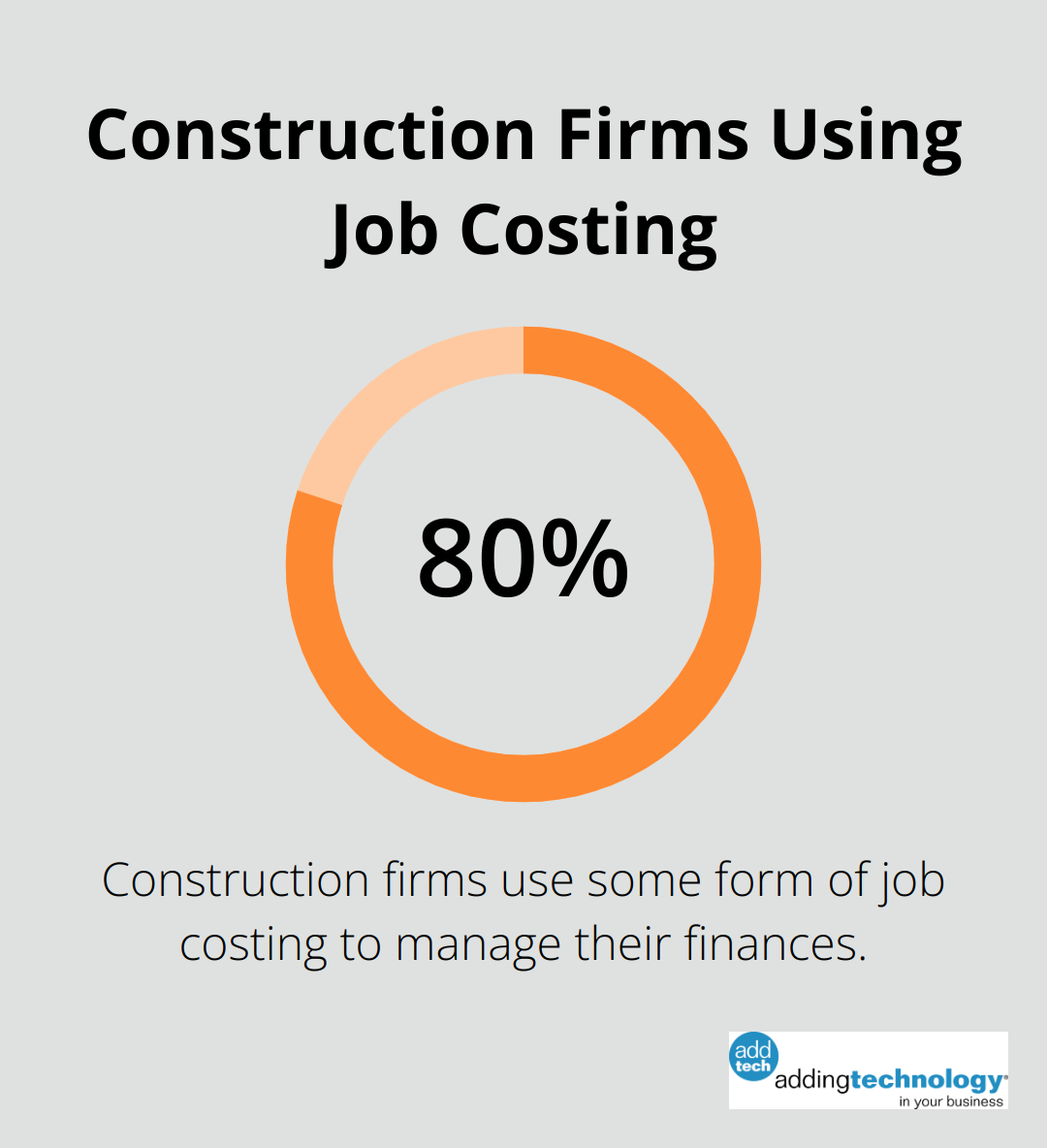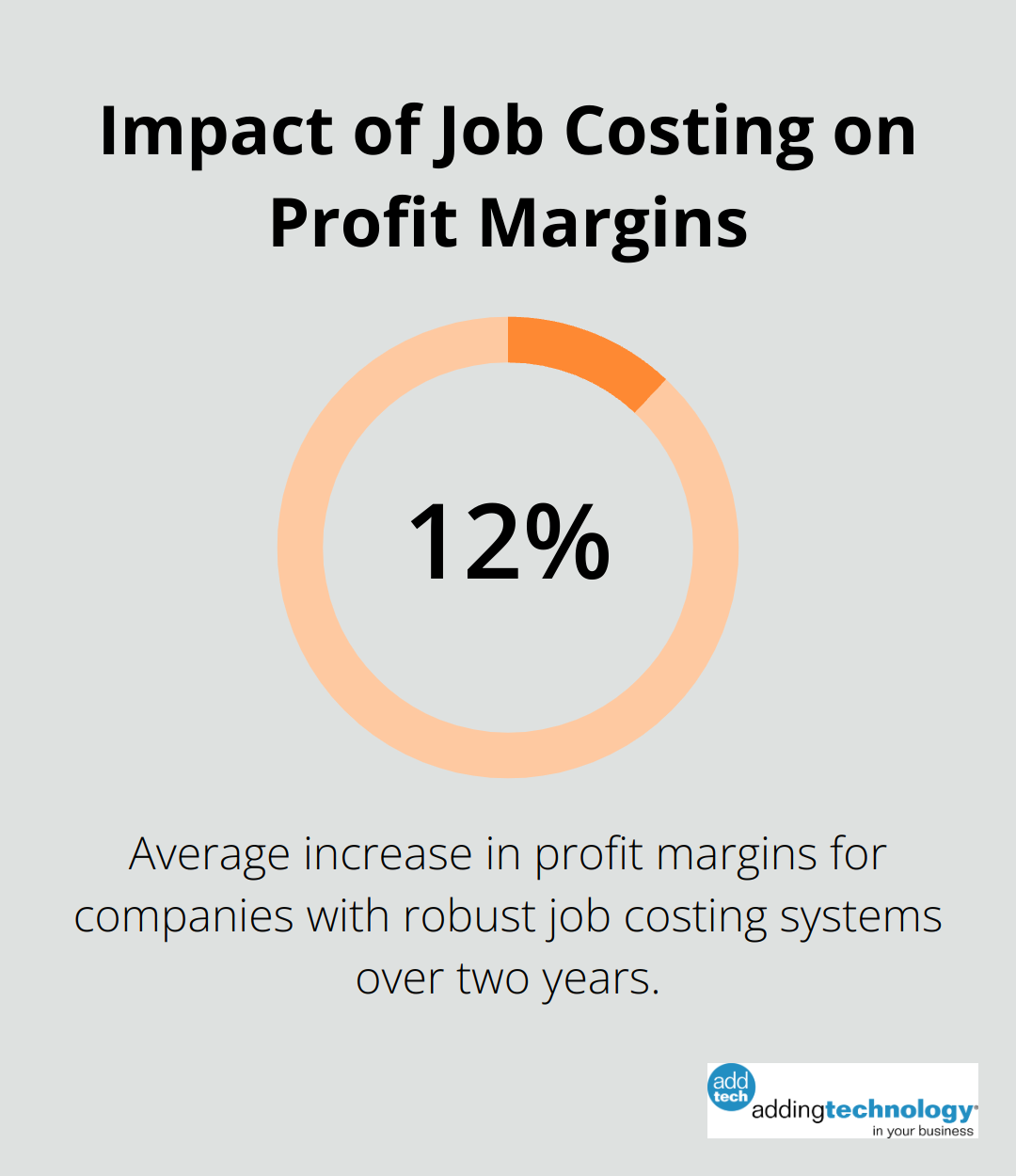
At adding technology, we understand the importance of accurate cost tracking for businesses. Job costing is a powerful method that allows companies to allocate expenses to specific projects or tasks.
In this post, we’ll explore the key job costing characteristics that can help you make informed decisions about pricing and profitability. Whether you’re in construction, manufacturing, or professional services, understanding these features can significantly impact your bottom line.
Job costing is a powerful accounting method that enables businesses to track and allocate costs to specific projects or jobs. This approach can transform financial management for construction companies and other project-based industries.
Job costing involves meticulous tracking of all expenses related to a particular project. This includes direct costs (materials and labor) and indirect costs (overhead). By assigning these costs to individual jobs, businesses obtain a clear picture of the true cost of each project.
For instance, a construction company using job costing would track the exact amount of lumber used for a specific house, the hours worked by each crew member on that house, and a portion of the company’s overhead expenses allocated to that project.
Job costing proves particularly valuable in the construction industry, but its applications extend far beyond. Manufacturing companies use it to track costs for custom orders. Service-based businesses (law firms and marketing agencies) employ job costing to understand the profitability of individual client projects.
A survey by the Construction Financial Management Association revealed that over 80% of construction firms use some form of job costing to manage their finances.

Accurate job costing plays a key role in setting competitive yet profitable prices. Without it, businesses risk underpricing their services and reducing their profit margins.
The benefits of job costing are clear, but implementation can present challenges. It requires detailed record-keeping and often necessitates changes to existing accounting processes. Many businesses struggle with accurately allocating overhead costs to individual projects.
However, these challenges can be overcome with the right tools and expertise. Modern accounting software has made job costing more accessible than ever, allowing even small businesses to reap its benefits.
Technology plays a significant role in streamlining job costing processes. Automation reduces the repetitive and monotonous tasks humans have to do by relegating those tasks to software, which usually means better efficiency. Advanced software solutions (like those offered by Adding Technology) can automate cost allocation, provide real-time insights, and generate detailed reports. These tools can significantly reduce the time and effort required for accurate job costing, making it more feasible for businesses of all sizes.
As we move forward, let’s explore the essential components that make up an effective job costing system. Understanding these elements will help you implement this valuable financial management tool in your business.
Direct materials form the tangible base of job costing. These items directly contribute to producing a product or delivering a service. In construction, direct materials include lumber, steel, concrete, pipes, and electrical components. Accurate tracking of these materials is essential for:
Companies can implement a barcode system for inventory to reduce errors in material allocation.
Direct labor encompasses wages paid to employees who work directly on specific jobs or projects. This includes base pay, overtime, benefits, and payroll taxes. Accurate labor tracking is vital for:
Time-tracking software significantly improves the accuracy of labor cost allocation.
Overhead costs are expenses that can’t be directly attributed to a specific job but are necessary for running the business. These include rent, utilities, administrative salaries, and insurance. While often overlooked, overhead costs significantly impact project profitability.
A common mistake is underestimating overhead.
To accurately allocate overhead:

Job cost sheets bring all these components together. They provide a snapshot of a project’s financial health, tracking estimated versus actual costs for materials, labor, and overhead.
Effective job cost sheets should:
As we move forward, we’ll explore how to implement these job costing components effectively in your business, starting with choosing the right software and training your team.
The selection of appropriate job costing software is a key step in implementation. We recommend solutions that integrate with existing systems and provide real-time data updates. The first quarter of 2022 was a stressful time for commercial construction companies, with labor shortages and high material prices creating delays at jobsites.
When evaluating software options, prioritize these features:
The most expensive option doesn’t always equate to the best fit. Focus on finding a solution that aligns with your specific business needs and processes.
The success of job costing implementation depends on your team’s understanding and buy-in. Dedicate time to comprehensive training sessions. A study by the Project Management Institute examined similarities and dissimilarities in managerial opinions regarding SPM factors and their impact on project management capability (PMC).
Establish clear guidelines for cost allocation and reporting. Ensure each team member understands their role in the job costing process. This might include:
Schedule regular refresher training sessions to maintain accuracy and consistency in your job costing practices.
The integration of job costing with your current accounting system is vital for maintaining financial accuracy. This process often requires careful planning and execution.
Map out how job costing data will flow through your organization. Identify potential bottlenecks or areas where manual data entry might introduce errors. Then, work with your software provider or IT team to create automated data transfer processes where possible.
Many construction companies find success by implementing job costing in phases. This approach allows for smoother transitions and gives your team time to adjust to new processes.
Monitor the integration closely in the first few months. Be prepared to make adjustments as needed. Regular audits of your job costing data can help ensure accuracy and identify areas for improvement.
Effective job costing implementation can significantly impact your bottom line. A study by the Construction Financial Management Association found that companies with robust job costing systems saw an average increase in profit margins of 12% over two years.

Job costing characteristics provide businesses with powerful financial management tools. These features enable accurate cost tracking, precise pricing, and improved profitability analysis for project-based industries. Companies that implement job costing often experience enhanced financial control and better decision-making capabilities.
Adding Technology specializes in job costing solutions for construction businesses. We offer tailored systems that streamline processes and boost operational efficiency (without making unverified claims). Our expertise in construction accounting allows us to provide comprehensive support for businesses transitioning to job costing methods.
Successful job costing implementation requires ongoing commitment and regular adjustments. The long-term benefits in financial clarity and improved profitability make it a worthwhile investment for any project-based business. Take the first step today towards more precise financial management and watch your business thrive.









At adding technology, we know you want to focus on what you do best as a contractor. In order to do that, you need a proactive back office crew who has financial expertise in your industry.
The problem is that managing and understanding key financial compliance details for your business is a distraction when you want to spend your time focused on building your business (and our collective future).
We understand that there is an art to what contractors do, and financial worries can disrupt the creative process and quality of work. We know that many contractors struggle with messy books, lack of realtime financial visibility, and the stress of compliance issues. These challenges can lead to frustration, overwhelm, and fear that distracts from their core business.
That's where we come in. We're not just accountants; we're part of your crew. We renovate your books, implement cutting-edge technology, and provide you with the real-time job costing and financial insights you need to make informed decisions. Our services are designed to give you peace of mind, allowing you to focus on what you do best - creating and building.
Here’s how we do it:
Schedule a conversation today, and in the meantime, download the Contractor’s Blueprint for Financial Success: A Step by-Step Guide to Maximizing Profits in Construction.” So you can stop worrying about accounting, technology, and compliance details and be free to hammer out success in the field.